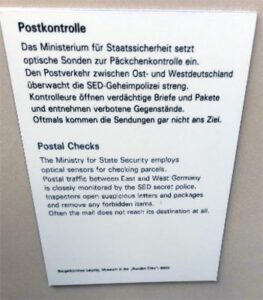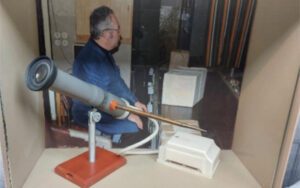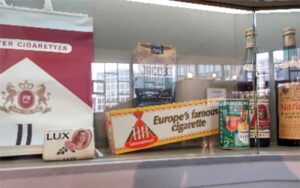I realize it has been a long time since my last post, but the last few months of 2022 and the beginning ones of 2023 were a roller coaster for my family. The craziness began in mid-October when my husband Brian and I signed the paperwork to purchase a home in the southeastern district of Berlin known as Rudow. Then less than a week later, thanks to a routine mammogram I was diagnosed with breast cancer and needed some time with my husband Brian and my doctors to debate and analyze my treatment options.
Luckily, we caught it early, and I had options that were available to me that were not available to my mother 30 years ago. In mid-December I had surgery to remove the tumor, and while still recovering, both of our dogs became extremely ill, and had to be taken multiple times to the emergency vet. As if that weren’t stressful enough, we moved into our new home in the middle of January, Brian began a brand new job the first of February, and I began my 4 week course of radiation therapy in February. Luckily as March winds down, our lives had calmed down a bit too. All four of us are doing well, we are settled into our new home, Brian is adapting to his new job, and I can seriously begin the research for my next book, We are all Berliners: The experiences of the Northern Irish during the IRA struggles and the Eastern Germans during the Cold War. My initial research for this ambitious project is the real topic of this post.
 While the purpose of the book is to compare the people of Berlin with the citizens of Northern Ireland, the next several posts will focus solely on Berlin because it is closer to me, and it is a little easier since I know more about the Cold War than I know about Irish History and the IRA. If all goes according to plan, I will finish my Berlin research by the end of the year and can begin research in Ireland at the start of 2024. I am super excited to see the complete analysis of the two. In the coming months, I plan to visit a series of museums and cites and conduct some interviews with Germans impacted by the Wall. As that work is done, I will update the blog more regularly, and I hope you will follow me on this exiting, but perhaps sometimes dark journey.
While the purpose of the book is to compare the people of Berlin with the citizens of Northern Ireland, the next several posts will focus solely on Berlin because it is closer to me, and it is a little easier since I know more about the Cold War than I know about Irish History and the IRA. If all goes according to plan, I will finish my Berlin research by the end of the year and can begin research in Ireland at the start of 2024. I am super excited to see the complete analysis of the two. In the coming months, I plan to visit a series of museums and cites and conduct some interviews with Germans impacted by the Wall. As that work is done, I will update the blog more regularly, and I hope you will follow me on this exiting, but perhaps sometimes dark journey.
In the initial research phase, I have spent the past few weeks reading secondary sources about Germany and more specifically Berlin during the Cold War. I cried tears of horror as I read the deplorable conditions under which people lived under the Soviet Rule, as well as tears of appreciation at the successful and often heroic efforts people endured to escape for the sake of freedom.
For example, I have read multiple stories of people successfully swimming across one of Berlin’s rivers, or canals from the East to the West. I listened to a story of some college students who dug a tunnel to help people escape via that method. Conversely, I uncovered stories about various police forces or armies enforcing “shoot to kill” orders where government officials shot anyone who attempted to flee to the West. I have read stories of Watch Towers, police dogs, and other forms of surveillance the East German citizens had to endure at the hands of the East German government. I have read accounts about the East German police hauling citizens off to jail for merely reading books that that had been banned in East Germany. Additionally, I have encountered examples of the East German government boarding up and sealing apartment buildings and forcibly evicted residents from their homes in efforts to prevent people on the border between East and West Berlin from jumping out their windows in hopes of making it to freedom on the side of the street. Th4ese examples are just a sample of what living conditions were like in the former German Democratic Republic (GDR).
 While the majority of my research up to this point has been limited to news clippings, and books, Berlin is an amazing city with an amazing, and often dark history. I came across this book: A Travel Guide to Cold War Sites in East Germany: East German/Soviet-Themed Museums and Memorials Open for a Visit in Berlin and the Former GDR by Carlo R. I figured I am fortunate enough to have all of these museums and sites easily at my disposal it would a wonderful opportunity to take advantage of the wealth of information they undoubtedly provide to enhance my research. I visited the 1st such site, Tränenpalast Ort der deutschen Teilung, or the Palace of Tears. It is a museum outside of the Friedrichstraße S-Bahn station in Berlin, where quite literally the station was a dividing line between the two Berlins. Among the many valuable things I discovered in this museum was a machine used to sort mail to detect “contraband” such as tobacco, food, or banned magazines/newspapers. Another interesting artifact the Museum had was some love letters between a young couple separated by the Wall between a West Germany woman, Katitja and an East German man, Marcus. The two express the hardships of living apartment and the probability of never being able to be together because of the Wall.
While the majority of my research up to this point has been limited to news clippings, and books, Berlin is an amazing city with an amazing, and often dark history. I came across this book: A Travel Guide to Cold War Sites in East Germany: East German/Soviet-Themed Museums and Memorials Open for a Visit in Berlin and the Former GDR by Carlo R. I figured I am fortunate enough to have all of these museums and sites easily at my disposal it would a wonderful opportunity to take advantage of the wealth of information they undoubtedly provide to enhance my research. I visited the 1st such site, Tränenpalast Ort der deutschen Teilung, or the Palace of Tears. It is a museum outside of the Friedrichstraße S-Bahn station in Berlin, where quite literally the station was a dividing line between the two Berlins. Among the many valuable things I discovered in this museum was a machine used to sort mail to detect “contraband” such as tobacco, food, or banned magazines/newspapers. Another interesting artifact the Museum had was some love letters between a young couple separated by the Wall between a West Germany woman, Katitja and an East German man, Marcus. The two express the hardships of living apartment and the probability of never being able to be together because of the Wall.
The museum is well worth the visit, and I strongly encourage anyone interested in the Cold War visiting to Berlin should spend some time. It can be done in about 90 minutes, and it is free. There are often many school groups there, so just be mindful it does get loud and chaotic at times, but I reminded myself how important it is that the children are learning about their history.
 One of the jobs a historian has is to tie past events with current trends and make comparisons, teach and educate about the similarities, and warn of dangerous—when necessary. Both the Berlin Wall and the Irish Peace Walls happened over forty-years ago. Once could argue why examine these events now? What purpose does dredging up the past have now? One can argue that the Cold War ended 30 years ago, that is irrelevant today. However, as much as I would like to believe that to be true, I see many parallels between the Berlin Wall and the arguments in favor of building the infamous border wall between the U.S. and Mexico that Trump like so many conservatives would like to construct. Building a wall is only one component—keeping it staffed, and “effective” is quite another. East Germany literally was a fascist police state and it took several different units of police and army to keep it guarded. Is that really how people want to live their lives? Do they really think that is going to make them safer?
One of the jobs a historian has is to tie past events with current trends and make comparisons, teach and educate about the similarities, and warn of dangerous—when necessary. Both the Berlin Wall and the Irish Peace Walls happened over forty-years ago. Once could argue why examine these events now? What purpose does dredging up the past have now? One can argue that the Cold War ended 30 years ago, that is irrelevant today. However, as much as I would like to believe that to be true, I see many parallels between the Berlin Wall and the arguments in favor of building the infamous border wall between the U.S. and Mexico that Trump like so many conservatives would like to construct. Building a wall is only one component—keeping it staffed, and “effective” is quite another. East Germany literally was a fascist police state and it took several different units of police and army to keep it guarded. Is that really how people want to live their lives? Do they really think that is going to make them safer?
Similarly, the horror stories I have read and heard of the police and military shooting people multiple times reminds me of the black lives matter and the police brutality that is prevalent in the United States. And finally, the ongoing news reports of books being banned and removed from classrooms across the United States sounds eerily familiar to the research I have seen on life in East Germany during the Communist Rule. Of course I am still in the initial research stages, so I am in no position to draw any conclusions, I do hope that you will stay tuned.


Hi Claudia!
I love your new topic of research/and the subject for your next book! This gives me an idea of what’s currently happening in your life (sorry I didn’t read it before I sent my recent email to you). BTW, my Godson, George, was just in Londonderry/Derry for the World Games in hurling, and I couldn’t help but read up on the history of that walled city, and of course “Bloody Sunday”. I’m excited for you and your research!